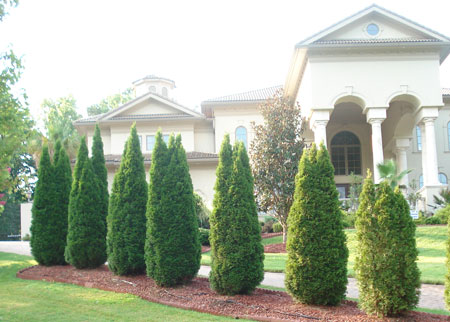Trees as Fences

From the hedgerows of Normandy France, to the Bamboo thickets of Southeast Asia, humans have used trees as fences ever since we learned to cultivate the land. Nowhere have tree-lined boundaries been so important as in Atlanta, where the dense, but private, residential neighborhoods meet a desire for lush green landscapes.
Here are some of the most popular trees used for living fences in the Atlanta area; some good, some bad, and some ugly:
Leyland Cypress
The king of all boundary trees, the Leyland Cypress reigns supreme. It continues to be planted year after year, with nurseries continuing to grow this inexpensive evergreen. This tree grows quickly, and develops a thick pyramidal form. But is it really the solution to screen the neighbor’s back yard? Unfortunately, the Atlanta environment is hot and humid, two of the key conditions that predispose Leyland Cypress to a long list of fungal diseases. Droughty summers stress the tree, and the humid air in the spring and fall predispose the foliage to infection. The tree also requires at least 8 hours of full uninhibited sunlight per day during the growing season.
Our recommendation: If you can manage proper watering and arrange for full sun exposure, Leyland Cypress is a good tree in youth. However, you should expect that the tree could develop fungal problems during its lifetime and its maximum useful life expectancy is probably 20-25 years.
Cryptomeria Japonica
Like the Leyland Cypress, Cryptomeria develop a fast growing pyramidal form. With generous full sunlight, this tree can grow several feet per year and develop a dense canopy for moderately-effective screening. This tree has become wildly popular as a substitute for the Leyland Cypress. There are no major pests of this species in Atlanta, but they can develop some minor insect and fungal problems like any tree. The canopy does expand widely at the bottom, so if the landscape constraints are tight, this tree is not a good choice. Unfortunately some Cryptomeria are showing symptoms of low heat resistance in the South. It’s is possible that we are finding Atlanta may be the southernmost range for this species.
Our Recommendation: We really like the Cryptomeria. It is a beautiful, and formal-looking tree in youth, and the first 16 years are probably its most attractive. If protected from heat, it could be a long-lived evergreen. We do see that they are often planted in spaces too small for full maturity.
Arborvitae ‘Emerald Green’
Quickly becoming a contender as a screening champion, this variety of medium evergreen tree has a tight form with lush fan-like twig clusters. Arborvitae grow with a dense form and can fit into landscape spaces where other trees cannot. The challenge for this tree is giving it enough sunlight. Arborvitae must have 8-10 hours of full sun during the growing season to have a chance of flourishing. Any less sunlight than that, and the trees are at risk of contracting fungal diseases, and their canopies become thin and sickly.
Our Recommendation: Arborvitae have a soft but formal appearance that fits into any landscape. We highly recommend considering this variety of Arborvitae but only if the tree can get constant direct sunlight and it is planted in an area that is not too moist. The ‘Green Giant’ variety is another great Arborvitae, but with a more open canopy and taller maturity.
Holly
Often overlooked as being hard to manage and unruly, the Holly varieties (and they are many) will often grow where other evergreens cannot. When given enough sunlight, they will grow rather quickly and form an impenetrable mass with their spiny leaves and twisting branches. This species can tolerate some shade as well, but may not grow as fast as if they were in the open. Hollies also attract birds, not just for the fruit, but for the protection the evergreen leaves give them. Some good varieties are, but not limited to, ‘Nellie R. Stevens,’ ‘Savannah,’ ‘East Palatka,’ and Foster’s #2. Hollies do not tolerate overwatering, and usually do not require extra irrigation.
Our Recommendation: Hollies are an all-around utilitarian evergreen tree that is excellent for creating tough boundaries. They may not always look as graceful as some other evergreens, but they provide environmental benefits such critical cover for birds. For extra fun, place a bird feeder near a holly and spend your early morning watching who appears!
